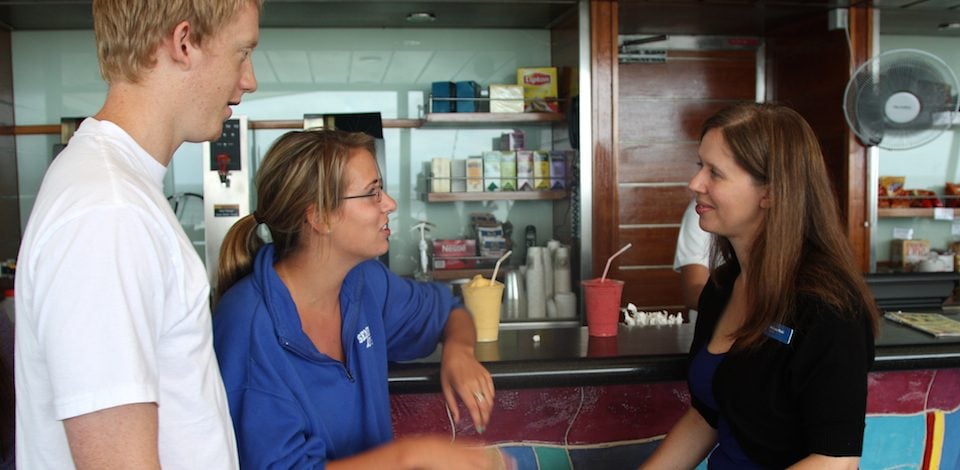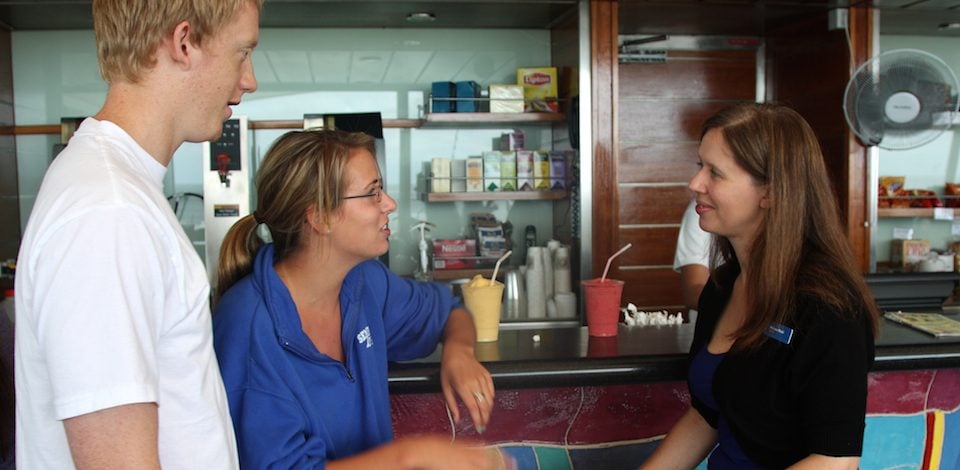
Guest post by Professor Ariana Maki
On my way to get some coffee the other afternoon, three students with books propped on their laps called out “Hi, Professor Maki!” as I passed by the pool deck. The next morning as I was slogging away on the elliptical, a cheerful voice at my elbow said, “Good morning, Professor!” and I turned to see a smiling student from my Buddhist art history class. This is definitely not the everyday learning environment. At the university where I completed my doctorate this past summer, I was both instructor and teaching assistant to art history courses with regular enrollments of 80-100 students. One-on-one interactions were limited to office hours, neatly compartmentalized into four hours per week. I’ll even confess there was more than one semester where I didn’t learn everyone’s names. Not once did I eat breakfast with students or exercise with them, let alone leave notes on the doors to their apartments. Most conversations about Semester at Sea center on what an incredible opportunity it is for the students. While this is certainly the driving force behind Semester at Sea, the transformations aren’t limited to those who were born in the 1990s; this voyage is impacting all of us.
As a faculty member, Semester at Sea has challenged me in a number of ways in matters both practical and professional. Such as, how to keep my balance while lecturing when we’re in 10-foot seas or whether to suspend class for five minutes so everyone can run outside to see humpback whales or dolphins playing nearby (answers: wide stance with three point contact and yes). And because of our unique circumstances, the classroom environment is much more dynamic. I’m free to foster a more intimate and creative learning environment that incorporates the immediate, real world encounters we’re all having with these traditions and cultures. Rather than relying on images to be the main conduit of visual information into the classroom, we have the unparalleled luxury of stepping into the cultures we’re studying.

During a field lab in Shanghai, one of my classes saw some of the best examples of early Chinese art in the world, including six objects from our textbook. Seeing these works first hand and further, being able to appreciate them in an informed way, provides a far more meaningful encounter than looking at a picture. And the everyday environments of our ports have provided equally substantive experiences and revelations. In Ho Chi Minh City, the History of Art I class visited three different temples, where we observed the vibrant and often syncretic religious traditions that fuel modern Vietnamese ritual life. We saw how locals propitiate Confucian and Buddhist shrines, how families mourn the loss of honored loved ones, and how people celebrate the Lunar New Year. While visiting Japan, my Buddhist art class traveled to temples that represented the rich variety of Buddhist traditions in the country: Zen, Pure Land and Mahayana, an experience that has enabled them to continue to recognize Buddhist art throughout our stays in China, Vietnam and Singapore.
Without fail, students approach me after each port with pictures of art objects, local rituals or sacred sites that they came across in their travels; things that they recognize and understand from our work in the classroom. They’ve brought their newly purchased scroll paintings or small sculptures to class for us to see, study and discuss. Every day, I’m seeing and hearing that their experiences in these ports are all the richer thanks to our efforts as faculty (not to mention the tireless efforts of the staff and crew). Yet I frequently wonder if they realize that they are helping me to become a better teacher, or if they could possibly understand how much joy I feel when they share discoveries that took place thanks to something we studied in class.
Is it odd to be in a Zumba class with a student, to happen across some of them sunbathing while studying, or to know who is gluten intolerant? Yes, it is a bit strange at first, but far more powerful are the lessons we’re learning inside and outside the classroom: to engage the world, to learn about each other, to stay curious, and to keep your balance no matter what.



